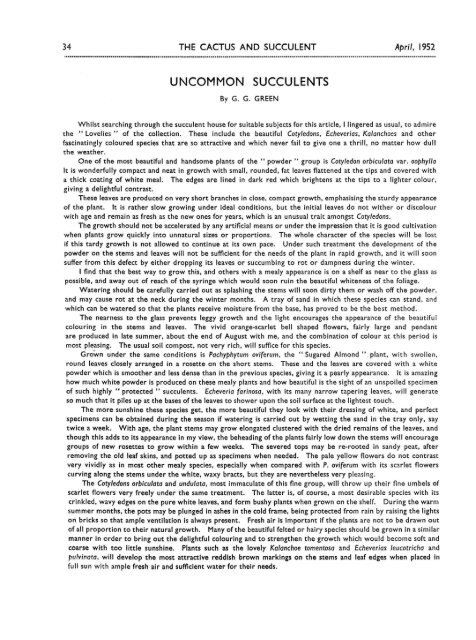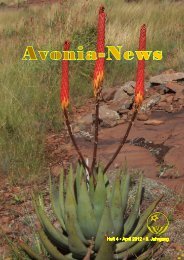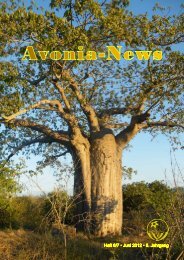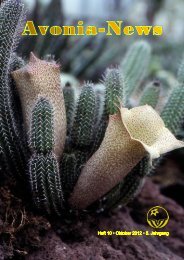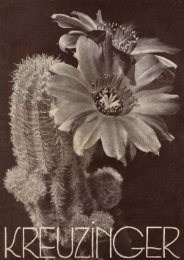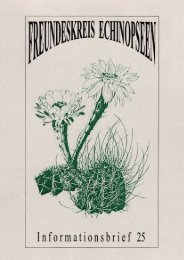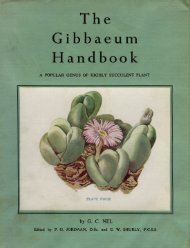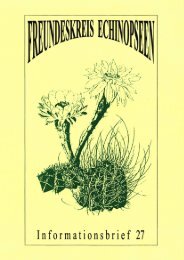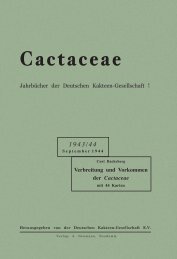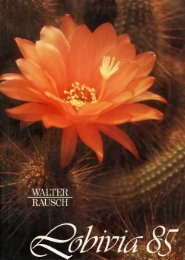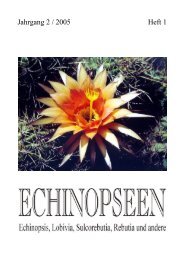VOLUME 14 :: January—October, 1952 Illustrations shown in ...
VOLUME 14 :: January—October, 1952 Illustrations shown in ...
VOLUME 14 :: January—October, 1952 Illustrations shown in ...
Create successful ePaper yourself
Turn your PDF publications into a flip-book with our unique Google optimized e-Paper software.
34 THE CACTUS AND SUCCULENT April, <strong>1952</strong><br />
UNCOMMON SUCCULENTS<br />
By G. G. GREEN<br />
Whilst search<strong>in</strong>g through the succulent house for suitable subjects for this article, I l<strong>in</strong>gered as usual, to admire<br />
the " Lovelies " of the collection. These <strong>in</strong>clude the beautiful Cotyledons, Echeverias, Kalanchoes and other<br />
fasc<strong>in</strong>at<strong>in</strong>gly coloured species that are so attractive and which never fail to give one a thrill, no matter how dull<br />
the weather.<br />
One of the most beautiful and handsome plants of the " powder " group is Cotyledon orbiculata var. oophylla<br />
It is wonderfully compact and neat <strong>in</strong> growth with small, rounded, fat leaves flattened at the tips and covered with<br />
a thick coat<strong>in</strong>g of white meal. The edges are l<strong>in</strong>ed <strong>in</strong> dark red which brightens at the tips to a lighter colour,<br />
giv<strong>in</strong>g a delightful contrast.<br />
These leaves are produced on very short branches <strong>in</strong> close, compact growth, emphasis<strong>in</strong>g the sturdy appearance<br />
of the plant. It is rather slow grow<strong>in</strong>g under ideal conditions, but the <strong>in</strong>itial leaves do not wither or discolour<br />
with age and rema<strong>in</strong> as fresh as the new ones for years, which is an unusual trait amongst Cotyledons.<br />
The growth should not be accelerated by any artificial means or under the impression that it is good cultivation<br />
when plants grow quickly <strong>in</strong>to unnatural sizes or proportions. The whole character of the species will be lost<br />
if this tardy growth is not allowed to cont<strong>in</strong>ue at its own pace. Under such treatment the development of the<br />
powder on the stems and leaves will not be sufficient for the needs of the plant <strong>in</strong> rapid growth, and it will soon<br />
suffer from this defect by either dropp<strong>in</strong>g its leaves or succumb<strong>in</strong>g to rot or dampness dur<strong>in</strong>g the w<strong>in</strong>ter.<br />
I f<strong>in</strong>d that the best way to grow this, and others with a mealy appearance is on a shelf as near to the glass as<br />
possible, and away out of reach of the syr<strong>in</strong>ge which would soon ru<strong>in</strong> the beautiful whiteness of the foliage.<br />
Water<strong>in</strong>g should be carefully carried out as splash<strong>in</strong>g the stems will soon dirty them or wash off the powder,<br />
and may cause rot at the neck dur<strong>in</strong>g the w<strong>in</strong>ter months. A tray of sand <strong>in</strong> which these species can stand, and<br />
which can be watered so that the plants receive moisture from the base, has proved to be the best method.<br />
The nearness to the glass prevents leggy growth and the light encourages the appearance of the beautiful<br />
colour<strong>in</strong>g <strong>in</strong> the stems and leaves. The vivid orange-scarlet bell shaped flowers, fairly large and pendant<br />
are produced <strong>in</strong> late summer, about the end of August with me, and the comb<strong>in</strong>ation of colour at this period is<br />
most pleas<strong>in</strong>g. The usual soil compost, not very rich, will suffice for this species.<br />
Grown under the same conditions is Pachyphytum oviferum, the "Sugared Almond "plant, with swollen,<br />
round leaves closely arranged <strong>in</strong> a rosette on the short stems. These and the leaves are covered with a white<br />
powder which is smoother and less dense than <strong>in</strong> the previous species, giv<strong>in</strong>g it a pearly appearance. It is amaz<strong>in</strong>g<br />
how much white powder is produced on these mealy plants and how beautiful is the sight of an unspoiled specimen<br />
of such highly " protected " succulents. Echever/a far/noso, with its many narrow taper<strong>in</strong>g leaves, will generate<br />
so much that it piles up at the bases of the leaves to shower upon the soil surface at the lightest touch.<br />
The more sunsh<strong>in</strong>e these species get, the more beautiful they look with their dress<strong>in</strong>g of white, and perfect<br />
specimens can be obta<strong>in</strong>ed dur<strong>in</strong>g the season if water<strong>in</strong>g is carried out by wett<strong>in</strong>g the sand <strong>in</strong> the tray only, say<br />
twice a week. With age, the plant stems may grow elongated clustered with the dried rema<strong>in</strong>s of the leaves, and<br />
though this adds to its appearance <strong>in</strong> my view, the behead<strong>in</strong>g of the plants fairly low down the stems will encourage<br />
groups of new rosettes to grow with<strong>in</strong> a few weeks. The severed tops may be re-rooted <strong>in</strong> sandy peat, after<br />
remov<strong>in</strong>g the old leaf sk<strong>in</strong>s, and potted up as specimens when needed. The pale yellow flowers do not contrast<br />
very vividly as <strong>in</strong> most other mealy species, especially when compared with P. oviferum with its scarlet flowers<br />
curv<strong>in</strong>g along the stems under the white, waxy bracts, but they are nevertheless very pleas<strong>in</strong>g.<br />
The Cotyledons orbiculata and undulata, most immaculate of this f<strong>in</strong>e group, will throw up their f<strong>in</strong>e umbels of<br />
scarlet flowers very freely under the same treatment. The latter is, of course, a most desirable species with its<br />
cr<strong>in</strong>kled, wavy edges on the pure white leaves, and form bushy plants when grown on the shelf. Dur<strong>in</strong>g the warm<br />
summer months, the pots may be plunged <strong>in</strong> ashes <strong>in</strong> the cold frame, be<strong>in</strong>g protected from ra<strong>in</strong> by rais<strong>in</strong>g the lights<br />
on bricks so that ample ventilation is always present. Fresh air is important if the plants are not to be drawn out<br />
of all proportion to their natural growth. Many of the beautiful felted or hairy species should be grown <strong>in</strong> a similar<br />
manner <strong>in</strong> order to br<strong>in</strong>g out the delightful colour<strong>in</strong>g and to strengthen the growth which would become soft and<br />
coarse with too little sunsh<strong>in</strong>e. Plants such as the lovely Kalanchoe tomentosa and Echeverias leucotricha and<br />
pulv<strong>in</strong>ata, will develop the most attractive reddish brown mark<strong>in</strong>gs on the stems and leaf edges when placed <strong>in</strong><br />
full sun with ample fresh air and sufficient water for their needs.


